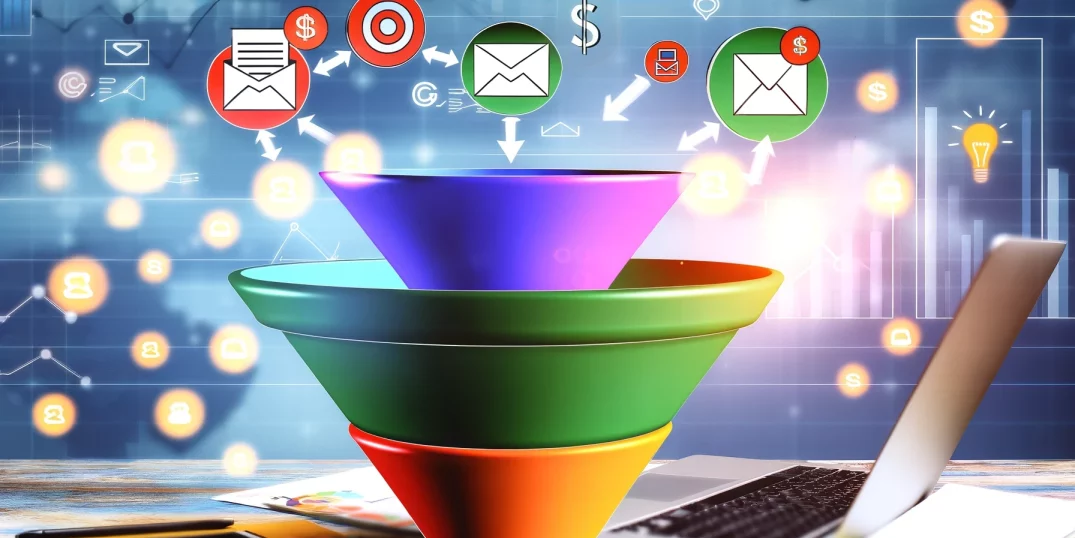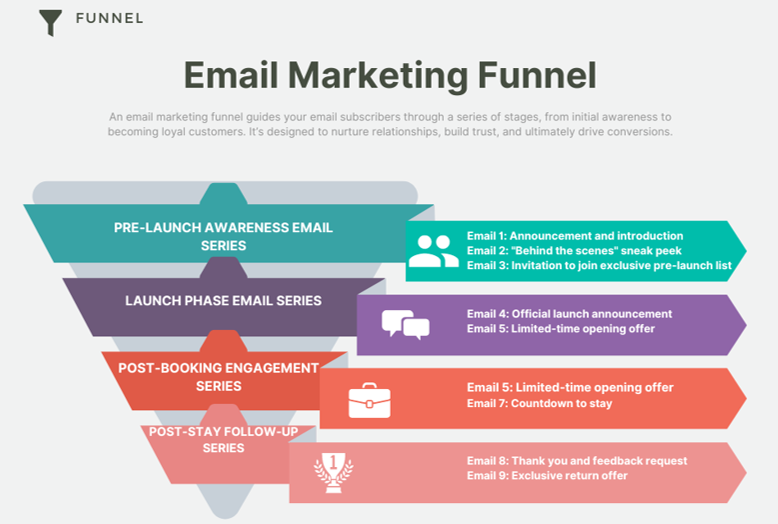- Home
- Fundamentals of Email Marketing
- Building an Email Marketing Fu ...

Email funnels are the foundation of marketing strategies. They take your potential customers on an adventure from initial awareness of your brand, products and services all the way to conversion. Putting it simply, email funnels are a series of carefully structured emails that are designed to engage, nurture, and convert leads into loyal customers.
Over 60% of email marketers spend two weeks or more crafting a single email, but a single email won’t deliver the same results as a well-built funnel. But to understand the mechanics of email funnels, we will need to go a bit deeper. Keep reading to learn how to create an effective email funnel, optimize your campaigns, and save time on email crafting while boosting your results!
Types of Email Funnels
1. Welcome email series
The welcome email series is the first step in building a relationship with new subscribers. It sets the tone for what communication will follow. These emails introduce your brand, highlight key products or services, and encourage readers to continue the conversation: for instance, follow the brand on social media or make their first purchase.
2. Lead nurturing email series
Lead nurturing emails guide your potential customers through the sales funnel. They give subscribers the necessary information and resources based on what they are interested in.This email series keeps your brand at the top of their minds and words towards building trust.
3. Sales conversion email series
The sales conversion email series takes leads and turns them into paying customers. These emails often feature special offers, limited-time promotions, or exclusive product information. They also play with the sense of urgency and try to offer very strong motivation for the subscriber to make a purchase.
4. Post-purchase follow-up series
After a customer makes a purchase, you may want to follow up with a series of emails. These emails aim to enhance their experience, encourage retention, and foster loyalty. They may include thank-you messages, product care tips, cross-sell or upsell recommendations, and requests for feedback or reviews.
5. Re-engagement email series
The re-engagement series targets subscribers who have become inactive or less engaged over time. They aim to recapture lost interest. The strategies these emails may use include offering special deals or asking customers to specify their preferences to tailor future communication further.
What Makes an Effective Email Funnel
- Subject lines that grab attention: The subject line is your first impression. This is how users decide if they will open your email. Effective subject lines are clear, intriguing, and relevant. They also promise value within the email.
- Personalization and segmentation: We keep saying this throughout our blog – but personalization is about more than just using the recipient’s name. It is about tailoring the content of your emails to match what different segments of your readers are interested in. Segmentation lets marketers send targeted emails to subgroups within their emailing list – and it is a very effective way to boost open rates.
- Content that provides value: The core of any email should offer value to the recipient. This could be in the form of educational content, entertainment, or exclusive offers. The key is to understand your audience’s needs and interests and deliver content that resonates with them.
- Clear and compelling calls to action (CTAs): A strong CTA is absolutely necessary for taking your readers to the next step in the funnel. Your CTA could be about making a purchase, reading a blog post, or completing a survey. Make sure your CTA is clear, compelling, and easy to find.
- Timing and frequency of emails: The success of an email funnel also depends on when and how often emails are sent. This requires understanding the best times to reach your audience and the appropriate frequency to keep them engaged without overwhelming them.
Building an Email Marketing Funnel
To first build and then optimize an email funnel you need to plan carefully. Here are the key steps you will need to take:
1. Identifying your target audience
Before you launch any email marketing campaign, it’s crucial to know who you are talking to. Start by truly understanding your target audience’s demographics, interests, pain points, and behavior. This will let you tailor messages to best match what your audience wants to know and is relevant to them.
2. Defining your goals and objectives
What do you want to achieve with your email funnel? Maybe you want to increase product sales. Or, you may want to boost event sign-ups. When you set clear goals, you will be able to better focus your efforts and get better results from your funnel.
3. Crafting your email content strategy
Email content should be engaging, valuable, and aligned with your overall marketing strategy. It should also take your subscribers through each step of the funnel: starting at awareness and all the way to consideration, decision, and advocacy.
4. Choosing the right email marketing tools and software
The right tools can make or break your email funnel. When choosing an email marketing funnel, make sure it has all the functionality you need. This could be automation, segmentation, and analytics – you will need all of these features to create, send, and monitor your email campaigns efficiently.
5. Creating and segmenting your email list
Build your email list with a focus on quality over quantity. You can use lead magnets, sign-up forms, and other tactics to attract subscribers who are genuinely interested in your brand. The best next step would be to segment this list based on behavior, preferences, or demographics.
Best Practices for Email Funnel Optimization
- A/B testing for emails: Experiment with different elements of your emails. Play with subject lines, content, and call-to-action buttons, to see what works best for your audience. A/B testing can give you these valuable insights and improve your email funnel.
- Monitoring and analyzing email metrics: Keep a close eye on key performance indicators (KPIs). The most important KPIs to look into are open rates, click-through rates, conversion rates, and unsubscribe rates. Analyze these metrics: they will help you understand what’s working and what’s not.
- Adjusting strategies based on performance data: Use the insights gathered from your analytics and A/B testing to refine and adjust your email strategy. Use performance data and continue to optimize your email funnel for better results.
- Integrating with other marketing channels: All your “smaller” marketing efforts should be part of a larger, integrated marketing strategy. Coordinate your emails with social media, content marketing, and other channels to create a more effective approach.
Common Challenges and Solutions
To build a robust email marketing funnel, you will also need to be aware of the challenges you might face along the way – and have solutions ready.
Overcoming email deliverability issues
To improve email deliverability, make sure your email list is clean and engaged. Avoid spam trigger words in your emails, and authenticate your email domain. Regularly clean your list by removing inactive subscribers.
Engaging inactive subscribers
Re-engagement campaigns can be effective in winning back inactive subscribers. Try sending them a special offer, an update on what they’ve missed, or a simple email asking for their feedback or preferences.
Avoiding spam filters
To avoid spam filters, obtain consent from your subscribers, use a reliable email service provider, and avoid deceptive subject lines. Also, encourage your subscribers to add your email address to their address book.
Ensuring GDPR compliance
Complying with the GDPR and other privacy laws is crucial. Always obtain explicit consent before sending emails, provide a clear unsubscribe option, and be transparent about how you use subscribers’ data.
Email Marketing Funnel Example
Let’s consider the example of a new luxury hotel, “The Vista Retreat,” that’s about to open in a popular tourist destination. The hotel aims to create buzz, attract early bookings, and build a loyal customer base even before its official launch. Here’s how “The Vista Retreat” might structure its email funnel as part of its marketing campaign to achieve these goals.

Pre-launch awareness email series
Email 1: Announcement and introduction
- Content. Announce the upcoming hotel opening with a compelling story about the vision and unique value proposition of “The Vista Retreat.” Include quality images of the destination and teasers of the hotel amenities.
- Goal. Build excitement and curiosity.
Email 2: “Behind the scenes” sneak peek
- Content. Share exclusive “behind the scenes” content about the hotel’s design process, the inspiration behind its architecture, and the features that make it unique.
- Goal. Strengthen interest and emotional connection.
Email 3: Invitation to join exclusive pre-launch list
- Content. Offer subscribers the opportunity to join an exclusive list to receive early booking discounts, special offers, and first access to reservations.
- Goal. Convert interest into early commitment and gather a list of potential early customers.
Launch phase email series
Email 4: Official launch announcement
- Content. Announce the official launch of “The Vista Retreat,” including opening dates, and remind subscribers of the exclusive benefits of booking early. Include testimonials from early visitors or industry experts, if available.
- Goal. Drive early bookings and capitalize on the built-up anticipation.
Email 5: Limited-time opening offer
- Content. Present a compelling, limited-time offer to encourage immediate bookings. This could be a special discount rate, a complimentary upgrade, or an exclusive package that includes additional services like a spa treatment or a guided tour of the destination.
- Goal. Create a sense of urgency to prompt quick action.
Post-booking engagement series
Email 6: Booking confirmation and pre-arrival guide
- Content. Send a warm thank you message for the booking, along with a pre-arrival guide that includes tips for planning their stay, highlights of hotel amenities, and things to do in the area.
- Goal. Reinforce the decision to book and build anticipation for the stay.
Email 7: Countdown to stay
- Content. A week before arrival, send a “countdown” email with weather forecasts, packing tips, and a personalized itinerary suggestion based on the guest’s interests.
- Goal. Enhance the guest’s experience and engagement with the hotel brand.
Post-stay follow-up series
Email 8: Thank you and feedback request
- Content. After the guest’s stay, send a thank you email expressing gratitude for choosing “The Vista Retreat” and a request for feedback on their experience.
- Goal. Show appreciation, gather insights for improvement, and encourage repeat business.
Email 9: Exclusive return offer
- Content. Offer a special discount for a return visit or referral incentives to encourage them to spread the word about their positive experience.
- Goal. Foster loyalty and turn satisfied guests into brand ambassadors.
“The Vista Retreat” uses this email funnel to take potential guests on a journey. The journey starts at initial awareness and goes all the way to post-stay engagement and beyond.
To learn more about email marketing for hotels, check out this article: Email Marketing for Hotels: Key Strategies in 2024
To Sum Up
Email funnels are a very effective marketing tool.
As we see with our “The Vista Retreat” example, a well-structured email funnel is made up of a number of key stages: you start by making subscribers aware of your brand and then guide them towards conversion, engagement, and feedback.
Each element of the email marketing funnel serves its own distinct purpose. When executed properly, email marketing funnels will keep your subscribers stay continuously engaged, informed, and motivated to be part of your community.



